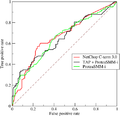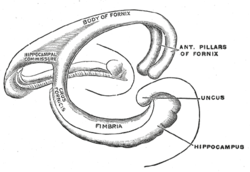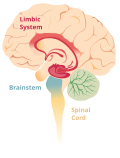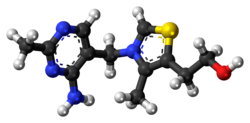Recognition memory, a subcategory of explicit memory, is the ability to recognize previously encountered events, objects, or people. When the previously...
76 KB (9,028 words) - 15:40, 9 March 2025
descriptions in memory. Stage 4 Semantic attributes are applied to the visual representation, providing meaning, and thereby recognition. Within these stages...
40 KB (5,293 words) - 17:06, 10 January 2025
reason about topics. Researchers distinguish between recognition and recall memory. Recognition memory tasks require individuals to indicate whether they...
138 KB (16,925 words) - 10:27, 15 April 2025
List of cognitive biases (redirect from List of memory biases)
(February 2011). "The list length effect in recognition memory: an analysis of potential confounds". Memory & Cognition. 39 (2): 348–63. doi:10.3758/s13421-010-0007-6...
109 KB (10,098 words) - 21:21, 2 May 2025
pattern recognition is a cognitive process that matches information from a stimulus with information retrieved from memory. Pattern recognition occurs...
35 KB (4,548 words) - 04:58, 5 November 2024
supporting poor facial recognition, something widely observed for M-LFA individuals. Implicit memory is non-declarative memory that relies on past experiences...
46 KB (5,722 words) - 21:03, 28 April 2025
with massed items, leading to improved recall. Cued-memory tasks (for example, recognition memory, and frequency estimation tasks) rely more on item information...
26 KB (3,651 words) - 10:27, 4 December 2024
Picture superiority effect (category Memory biases)
dual-process models, thought to underlie recognition memory is not clear. In experiments of associative recognition memory, participants studied random concrete...
23 KB (2,727 words) - 20:05, 17 December 2024
Face perception (redirect from Face pattern recognition)
theoretical "face recognition units" that are used with "personal identity nodes" to identify a person through information from semantic memory. Interestingly...
122 KB (14,546 words) - 16:39, 21 January 2025
measures memory functioning. It evaluates both immediate, delayed and recognition memory ability along with the acquisition of new learning. The WRAML3 is...
2 KB (217 words) - 23:55, 12 February 2025
Déjà vu (category Memory)
associated déjà vu experiences with good memory functions, particularly long-term implicit memory. Recognition memory enables people to realize the event or...
38 KB (4,387 words) - 18:26, 5 April 2025
types of tests: recognition memory tests and perceptual identification tests. These studies provided evidence that effects of memory on perceptual identification...
41 KB (5,584 words) - 09:44, 16 January 2025
Memory consolidation is a category of processes that stabilize a memory trace after its initial acquisition. A memory trace is a change in the nervous...
62 KB (7,295 words) - 07:37, 12 July 2024
significant Recall (memory), the retrieval of events or information from the past Emotion recognition Pattern recognition (psychology) Recognition (sociology)...
4 KB (514 words) - 15:39, 16 November 2023
with a loss of smell. Odor recognition is the most common and direct means used to measure odor memory. In an odor recognition test participants are asked...
42 KB (5,325 words) - 16:58, 24 April 2025
in episodic memory. The associated deficit is that differences in recognition memory reflect difficulty in binding components of a memory episode and...
45 KB (5,696 words) - 12:10, 3 April 2025
receiver-operating characteristic in recognition memory". Journal of Experimental Psychology: Learning, Memory, and Cognition. 25 (2): 500–513. doi:10...
61 KB (7,885 words) - 16:03, 10 April 2025
Memory has the ability to encode, store and recall information. Memories give an organism the capability to learn and adapt from previous experiences as...
60 KB (8,695 words) - 13:46, 11 February 2025
it has been found to most closely correlate with recall memory rather than recognition memory. This means that damage to the fornix can cause difficulty...
11 KB (1,372 words) - 15:32, 10 December 2024
finding has been supported by studies of many explicit memory tasks such as free recall, recognition, cued-recall, and frequency estimation (for reviews...
28 KB (3,598 words) - 17:52, 28 February 2025
Reconstructive memory is a theory of memory recall, in which the act of remembering is influenced by various other cognitive processes including perception...
32 KB (4,054 words) - 07:18, 29 April 2024
The recognition failure of recallable words is an experimental phenomenon in cognitive psychology originally discovered by the memory researcher Endel...
4 KB (490 words) - 20:09, 14 July 2023
the Rat Hippocampus Has Contrasting Roles in Object Recognition Memory and Object Recency Memory Lesion at Wikipedia's sister projects Definitions from...
9 KB (1,013 words) - 01:02, 16 February 2025
Wernicke–Korsakoff syndrome (category Memory disorders)
that assess perceptual priming. Other studies have shown deficits in recognition memory and stimulus-reward associative functions in patients with WKS. The...
38 KB (4,502 words) - 17:19, 17 March 2025
Boundary extension (category Memory)
original picture. Boundary extension is typically studied using a recognition memory test where participants are shown a series of photos and then shown...
15 KB (2,052 words) - 16:56, 13 April 2024
False recognition can occur as the result of making an implicit associative response, an automatic association between two concepts in memory. It is...
43 KB (5,779 words) - 16:02, 2 April 2025
closely associated with memory and in particular autobiographical memory. The temporal lobes are also concerned with recognition memory. This is the capacity...
26 KB (3,434 words) - 01:01, 16 December 2023
Cross-race effect (redirect from Interracial face-recognition deficit)
Pezdek K, Blandon-Gitlin I, Moore C (August 2003). "Children's face recognition memory: more evidence for the cross-race effect". The Journal of Applied...
45 KB (5,761 words) - 23:36, 15 February 2025
of recall and recognition memory. In summed similarity theory, the use of a memory matrix includes the context as an attribute in a memory vector. Other...
61 KB (7,757 words) - 01:07, 2 May 2025
been removed, is a dysfunction of visual memory. In humans, areas specialized for visual object recognition in the ventral stream have a more inferior...
37 KB (4,564 words) - 10:09, 16 January 2025








